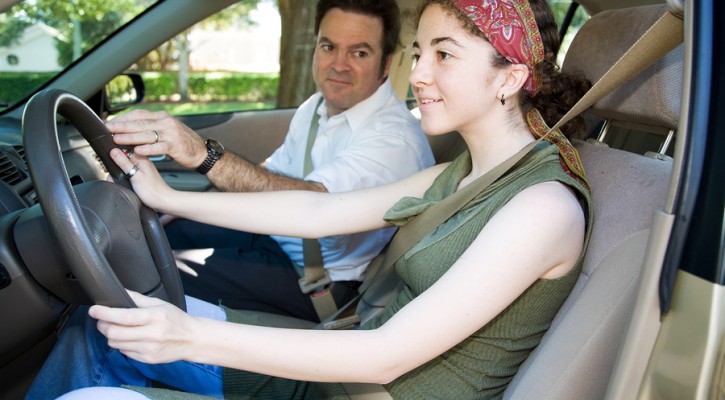Category Archive: Parents

How Teens Can Drive Safely on the Expressway
June 9, 2009
A complete driver-training program includes lessons on all types of streets and highways, both night and day, in a variety of weather and traffic conditions. But many teens get the majority, if not all, of their driver training on familiar roads close to home. Some young drivers do not make their first expressway trip until after they are licensed and driving on their own. This is a high-risk method for teens to gain driving experience, because:
- Young drivers who don’t have freeway experience have trouble controlling vehicles traveling at high speeds
- Teens have minimal experience in dealing with emergency driving situations, particularly at high speeds
- When expressways are unfamiliar to drivers, they spend more time searching the driving scene for directional signs and landmarks
- Teens often aren’t aware of the level of risk on interstates, so they may continue other risky driving behaviors, such as non-use of seat belts and allowing distractions such as loud music and noisy passengers
- Though expressways have a low incidence of collisions, the crashes that do occur have high injury severity rates because the higher speeds exponentially increase the amount of force involved in the crash
Commentary driving is an excellent way to train teens to drive safely on the expressway. With commentary driving, teens maintain a running dialogue of their progress – what they notice as they observe the roadway and what actions they will take: “The car in front of me is slowing down, so I’m slowing down and checking my following distance. My exit is coming up in one mile, so I’m putting on my turn signal, checking my mirrors and blind spot, and moving into the exit lane. The exit ramp has a posted speed limit of 45 mph, so I’m slowing to that speed. It’s starting to rain, so I’m increasing my following distance.”
Commentary driving forces the driver to use critical thinking skills to make driving decisions. The fact that the driver’s observations are verbalized is comforting to the person (typically a parent) teaching the teen to drive, because it allows the instructor to follow the teen’s thought process and quickly make corrections without lecturing, which teens tend to tune out anyway.
Teens often feel awkward about commentary driving, so it is helpful to model it for them prior to beginning driving lessons. This also allows parents to perfect the process and to see the roadway with new eyes, thus relating better to the beginning driver.
From a practical standpoint, it is obviously important for teens to work up to practicing driving on the expressway. The first several lessons should occur during non-peak hours on dry roads during the daytime. Introduce one variable – nighttime hours, rainy weather, rush-hour traffic – at a time, and ensure the teen is completely comfortable with each before progressing to the next.
The following training tips will help teens be safer drivers on the freeway:
- Make sure the teen understands that though traffic on the expressway can seem predictable because everyone is moving in the same direction at approximately the same speed, surprises can occur and drivers must be ready to deal with them at all times.
- Use commentary driving to make sure teens know how to identify interstate interchanges, signs, lane markings, and speed limits.
- Help teens learn how to enter and exit expressways properly: searching the road ahead, signaling, evaluating other drivers’ speed, calculating the amount of available space, adjusting speed to the flow of traffic, identifying exits early, and following exit ramp speed limits. Practice entering and exiting the freeway at different points to broaden the young driver’s experience.
- Include information in the lesson plan on how high speeds affect following distance, stopping distance, and the physics of motor vehicle crashes. To avoid overloading the young driver, provide these lessons off the road, or have teens take a driver safety course and report what they learned.
- Help teens understand how the steering needs of vehicles change at high speeds; excessive steering can cause drivers to lose control on the expressway.
- Reinforce that driving must be taken seriously; many traffic games occur on freeways. Make sure teen drivers maintain a steady lane position in the right lane, except when passing, and refrain from being competitive with other drivers.
- Talk about the dangers of the expressway, such as crosswinds when traveling on bridges or through mountain passes, other drivers tailgating them, and sharing the road with large trucks, and how to handle each one.

Driver Education: Traffic Safety for New High School Graduates
June 5, 2009
Summer is here and school is out. Many young drivers will be spending more time on the road going to the beach or pool, working at summer jobs, and having fun with friends. This is an especially exciting time for teens who are 2009 high school graduates. Recent grads are filled with elation, a sense of freedom, and hopes and dreams for the future. But euphoria and increased independence can cause problems when they lead relatively inexperienced drivers to take chances behind the wheel. And summertime is a dangerous time for drivers in general; traffic deaths for all drivers increase during the warm-weather months, peaking in July.
Three deadly holidays take place during the summer – Memorial Day, the Fourth of July, and Labor Day. According to the National Center for Statistics and Analysis, in a 2004 analysis of six holiday periods, the average number of traffic deaths during holiday periods was 156 per day, compared to 117 per day on non-holidays. According to the National Highway Traffic Safety Administration, 20 of the 25 deadliest days on US roads over a five-year time frame fell during the period from Memorial Day weekend to Labor Day.
Teen motor vehicle fatalities are also highest in the summer, partly because it’s an unsafe time for all drivers, but also due to risk factors specific to young drivers. Like other drivers, teens spend more time on the road during the summer (averaging 44% more hours driving each week, according to the NHTSA) and are more likely to drive at night. But they lack the experience of older drivers in dealing with heavy traffic and low-visibility conditions. Like other drivers, teens behind the wheel in the summer are often accompanied by multiple passengers. But teens are often much more distracted by their passengers than older drivers, and they are unlikely to assert themselves even when they are aware that they need to concentrate on driving.
Parents who want their teens to survive the summer must stay involved in their teens’ driving activities. Without close supervision, the vast majority of teens lack the emotional maturity to stay safe behind the wheel – or as passengers of other teen drivers.
-Though most parents will broaden driving privileges for summer, avoid giving teens too many privileges at once. Extend privileges one at a time and make sure teens prove they can handle the increased responsibility before adding more.
-Conduct supplementary driver training lessons. For example, many teens have limited experience with night driving during the school year; a few lessons will help them learn good nighttime driving habits from the beginning. A teen driving checklist helps parents provide valuable feedback on the driving lesson.
-A driver training course will help teens review fundamental driving concepts during a time when they are most at risk. A quick safe-driving refresher could help an inexperienced young driver make the right choice in an emergency. Parents whose teens receive even one traffic ticket must address the issue immediately; tickets mean teens are probably engaging in more risky driving behaviors than parents realize.
-Parents should check up on their teens’ seat belt use as often as possible. In 2006, the NHTSA reported that 58% of 16- to 20-year olds who were involved in fatal motor vehicle collisions were not wearing seat belts. The Insurance Institute for Highway Safety reports that teen seat belt use increases over time when strict parental limits are set.
-A heightened level of awareness about their teens’ access to alcohol, particularly on holidays, is critical for concerned parents. Teens may even have access to alcohol via their friends’ parents; ensure that teens understand that underage drinking is never acceptable, no matter what any other parent says or does, even for a special occasion. Create a codeword so your teen can ask to be picked up without risking the ridicule of friends.

Four Ways Teens Benefit from Following Graduated Driver Licensing Laws
May 8, 2009
It isn’t uncommon for teens to rebel against Graduated Driver Licensing (GDL) laws. They may reason that since they passed the driving test, they shouldn’t have to deal with restrictions. Or they may be unfamiliar with the GDL laws in their state and violate them unintentionally. But there are many benefits to obeying GDL laws for teens, such as:
1. They’re a chance to prove your maturity and trustworthiness. One of the basic requirements for functioning in our society is the ability to follow the rules. Teens who are unwilling to do so demonstrate a lack of maturity and make other people, specifically adults, think they can’t be trusted. Conversely, showing that you’re willing to abide by certain restrictions lets adults, specifically your parents, know that you are grown-up and dependable enough to handle additional privileges.
2. They can help you get out of risky situations with your pride intact. You may have the best intentions of following GDL laws, but sometimes friends make that a challenge. It might be hard to resist when a friend wants you to break curfew or pile one too many passengers into your vehicle; GDL laws give you an outside authority you can blame for your refusal to do these things. You can explain that you don’t want to get caught breaking the law because you might lose your license and/or your parents might ground you from driving if you get a traffic ticket.
3. They’re the law. You won’t be lying if you tell a friend you are afraid of losing your license for breaking GDL laws; violating the terms of the law could result in the loss of your driving privileges. If you get a ticket for breaking a GDL law, you will have to pay a fine and your insurance rates, which are already high, could increase. After accruing a certain number of points on your license, you could lose it for a specified period of time and have to pay more fines to get it back. Ignorance of the law is no excuse, so be sure to familiarize yourself with the GDL laws in your state.
4. They really do keep you safe. GDL laws exist because statistically, teens get into many more crashes than adult drivers. According to the National Highway Traffic Safety Administration (NHTSA), sixteen-year old drivers have crash rates that are about three times greater than 17-year-old drivers, five times greater than 18-year-old drivers, and approximately twice the rate of 85-year-old drivers. We know that GDL laws work, because there has been an overall decrease in fatal crashes involving teens nationally since GDL laws began to be implemented. Specific restrictions have also been found to be effective; for example, an NHTSA study found that states with nighttime driving restrictions for teen drivers show decreases in crashes of up to 60% during the restricted hours. GDL laws work because they help teens increase their driving skills while minimizing the risks of being on the road with limited experience.
You can probably see how these four factors tie together. If you break GDL laws, you show the adults in your life that you can’t be trusted, you are more likely to be peer-pressured into taking risks you know you shouldn’t take, you take a chance on losing your license, and you raise the possibility that you or someone riding with you will be injured or killed in a crash. When you choose to follow GDL laws, you have nothing to lose and everything to gain.

Support for Graduated Driver Licensing Laws
April 30, 2009
According to the National Highway Safety Administration (NHTSA), adolescent drivers, especially 16- to 17-year olds, are disproportionately involved in deadly motor vehicle crashes. Sixteen-year old drivers have crash rates that are about three times greater than 17-year-old drivers, five times greater than 18-year-old drivers, and approximately twice the rate of 85-year-old drivers. According to the NHTSA and the Insurance Institute for Highway Safety (IIHS), specific contributors to these higher crash rates include:
- Lack of driving experience and skills: Compared with crashes of older drivers, those of 16-year-olds more often involve driver error.
- A propensity towards risk taking behavior and poor decision-making.
- Driving at night: Per mile driven, the nighttime fatal crash rate for 16-year-old drivers is twice as high as during daytime hours.
- Distraction from teenage passengers: Fatal crashes involving 16-year-old drivers are more likely to take place when other teens are in the vehicle, and the risk increases with every additional passenger.
- Speeding: Sixteen-year old drivers have a higher rate of crashes in which excessive speed is a contributing factor.
Graduated Driver Licensing (GDL) programs help young drivers get driving experience progressively while minimizing risk, beginning with a restricted permit and eventually leading to full licensure.
Most programs include three stages:
- Learner Stage: Supervised driving, ending with a road test.
- Intermediate Stage: Limiting unsupervised driving in high-risk circumstances.
- Full Privilege Stage: A regular driver’s license.
Provisions of graduated licensing laws may include:
- Required hours of adult supervision during the learner stage.
- Restrictions on late-night driving.
- Restrictions on driving with teen passengers.
- Seat belt requirements for drivers and passengers.
- Restrictions on cellular phone use.
- Prohibiting the driver from moving up to the next level due to traffic violations.
GDL laws in most of the states that have them do not comply with all of the recommendations of the NHTSA; still, there has been an overall decrease in fatal crashes nationally since GDL laws began to be implemented. In 2006, 7,463 drivers who were 15 to 20 years old were involved in fatal crashes – an eight percent decrease from 8,074 involved in 1996. Individually, states with GDL laws also show improvement:
- California: A five percent decrease in crashes for 16- and 17-year-old drivers.
- Florida: A nine percent decrease in crashes for 16- and 17-year old drivers.
- Michigan: A 26% decrease in crashes for 16-year-old drivers.
- North Carolina: A 25% decrease in crashes for 16-year-old drivers.
- Oregon: A 29% decrease in crashes for 16-year-old drivers and a 16% decrease in crashes for 17-year-old drivers.
NHTSA research has also found that the most comprehensive GDL programs are associated with the greatest decrease in crash rates for teen drivers.
It is more difficult to evaluate the individual components of GDL laws because of the overlap of restrictions, but the NHTSA has conducted some research in this area. An analysis of the passenger restriction laws in California, Massachusetts, and Virginia indicated that there were 740, 173, and 454 fewer 16-year-old involved in crashes per year, respectively. A different study found that states with nighttime driving restrictions for teen drivers show decreases in crashes of up to 60% during the restricted hours.
Public support for GDL laws is also strong. In 2007, the NHTSA conducted the Motor Vehicle Occupant Safety Survey (MVOSS), a national telephone survey about driver safety. Seventy-nine percent of the participants said that teen drivers should proceed from a learner’s permit to a provisional license status rather than directly to an unrestricted adult license. The results of the survey also indicated strong support, ranging from 73% to 99%, for specific restrictions on provisional driver license status, such as:
- Requiring young drivers to wear a seat belt at all times.
- Prohibiting driving after 9pm, unless supervised by an adult.
- Limiting the number of teenage passengers allowed in the vehicle.
- Prohibiting the use of a cellular phone while driving.
- Requiring the new driver to hold the provisional license for at least one year without any traffic violations before receiving an unrestricted adult license.
GDL provisions are still in their infancy in many states, so evaluating the results of these programs is difficult. However, outcomes so far are promising. The enactment of and enforcement of these laws are important steps in efforts to save the lives of young drivers.

Driver Education: Commentary Driving
June 25, 2009
For most parents who are teaching their teens to drive, using commentary driving seems to make perfect sense. But like many other simple tasks, commentary driving is not always easy to do well, and if done improperly, can be frustrating for both the parent and teen.
Since commentary driving involves speaking out loud while driving, parents should model it for teens well before they allow the teen behind the wheel of the vehicle. Teens are likely to feel self-conscious about the process (and parents may, too), so several lessons just on the method itself will be helpful. Parents should emphasize the fundamentals; for example, taking note of the speed limit every time they enter a new street and watching for pedestrians in every crosswalk.
Just as they would with any other driving lesson, parents should begin practicing commentary driving in a relatively simple driving environment and progress to more complex situations, such as driving on the expressway. Each lesson in a new driving environment should be preceded by a demonstration by the parent of commentary driving in that environment; this allows teens to absorb some of the new hazards they will encounter from the safety of the passenger seat.
One purpose of commentary driving is to focus the driver’s attention on her or his thoughts, which in turn helps to maintain a high level of alertness. This is particularly helpful with teens, who may be struggling to overcome the excitement of finally getting to drive enough to focus on the process. It’s also helpful to parents, who otherwise might experience great anxiety as they wonder whether or not their teen has noticed hazards ahead, such as other drivers drifting out of their lanes or following too closely or cars parked on the side of the street.
While commentary driving involves talking while driving, the content of the discussion should be specific and targeted to the driving environment. The driver maintains a running list of observations and actions. An example of commentary driving is: “Approaching intersection….green light….car in oncoming lane waiting to turn left….checking mirrors….light still green….checking intersection….crossing intersection….”. Comments that are general, i.e., “checking ahead,” are not helpful because they don’t increase the awareness level of the driver. The person commenting should say what they see and how they plan to handle what they see.
Parents should resist the temptation to interject into teens’ comments unless absolutely necessary. Questions such as, “What would it mean if that traffic light was yellow?” and “How many seconds should your following distance be if it starts raining right now?” distract teens from what’s in front of them and teach them to rely on someone else’s observations instead of making their own. Parents should make note of any discussion points on a log and cover them at the end of the lesson when the vehicle is parked.
If teens get distracted and stop commenting, parents should encourage them to return to the process with general comments like, “Keep going; tell me everything you’re seeing and what you’re going to do.” When teens repeatedly stop commenting, they may be tired or overwhelmed, signaling that the lesson should end. After the lesson, parents can point out that when drivers stop commenting, their level of alertness goes down.
Parents can also ask questions that help teens understand how commentary driving works after the lesson is over. For example, ask, “Could you practice commentary driving while talking on your cell phone? How do you think talking on a cell phone affects a person’s driving?”
Commentary driving can be an effective driver education tool if used properly; parents who invest time and energy in the process help their teens to be better, safer drivers.